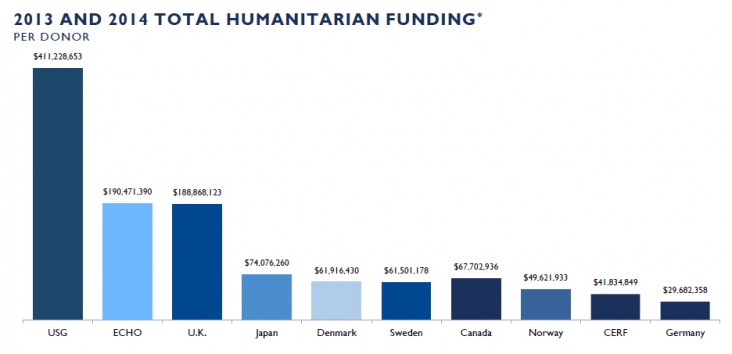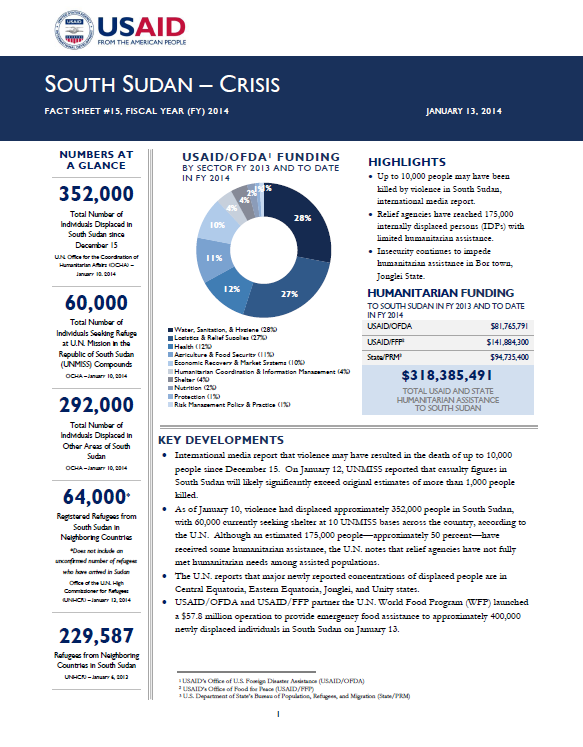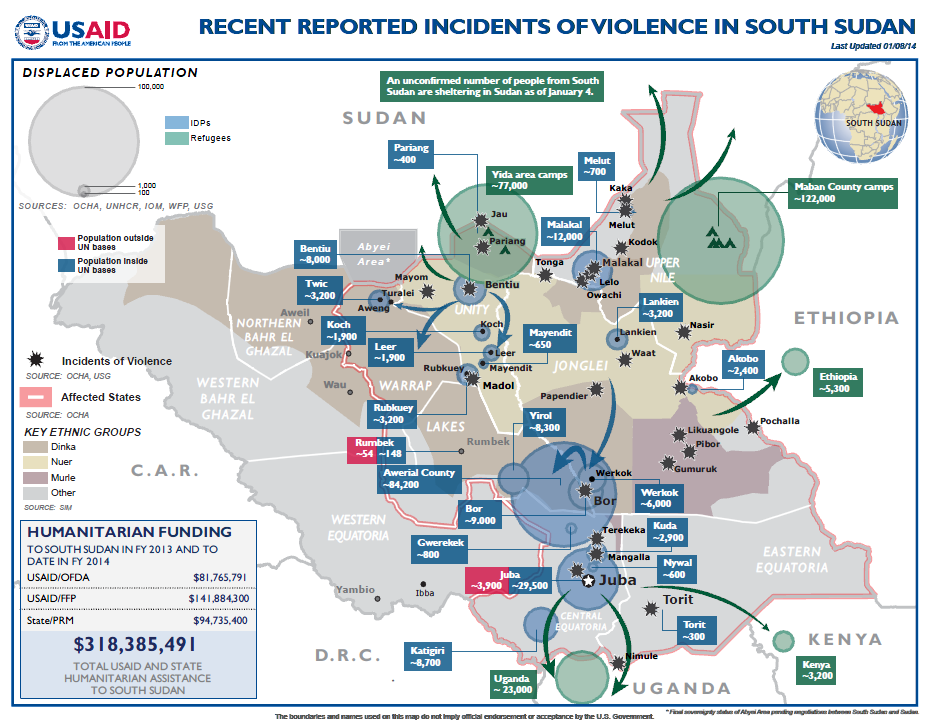- What We Do
- Agriculture and Food Security
- Democracy, Human Rights and Governance
- Economic Growth and Trade
- Education
- Environment and Global Climate Change
- Gender Equality and Women's Empowerment
- Global Health
- Humanitarian Assistance
- Transformation at USAID
- Water and Sanitation
- Working in Crises and Conflict
- U.S. Global Development Lab
Speeches Shim
January 21, 2014
Numbers At A Glance
494,000
67,400
426,600
86,100
229,600
Humanitarian Funding:
To South Sudan To Date In FY2013 and FY2014:
| USAID/OFDA | $81,765,791 |
| USAID/FFP | $141,884,300 |
| State/PRMDoD | $94,735,400 |
| TOTAL | $318,385,491 |
Highlights
Fighting continues in Malakal town, Upper Nile State.
Relief agencies reach more than 212,400 people with limited humanitarian assistance.
An estimated 86,100 refugees have fled from South Sudan to neighboring countries, including more than 46,600 people to Uganda.
KEY DEVELOPMENTS
Insecurity and fighting continue to severely affect communities and impede humanitarian access across South Sudan, with violence displacing more than 580,000 people both internally and as refugees to neighboring countries as of January 19, according to the U.N.
The security situation remains unpredictable and tense in areas affected by violence, particularly in Bor town, Jonglei State, and Malakal town, Upper Nile State, with persistent reports of targeted killings, looting, destruction of property, and other abuses that have affected civilians. Approximately 22,000 people continued to shelter at the UNMISS base in Malakal, while the number of civilians at the UNMISS base in Bor increased to an estimated 10,000 individuals as of January 19.
Despite access constraints, emergency relief operations continue to expand in South Sudan, and humanitarian agencies have provided limited humanitarian assistance to an estimated 212,400 people. Relief organizations are planning to implement new activities in areas hosting large concentrations of internally displaced persons (IDPs), such as Lankien town, Jonglei, and Nimule town, Eastern Equatoria State. Population displacement in remote areas, rapidly shifting security conditions, and looting and commandeering of humanitarian assets by armed actors are impeding robust, sustained relief efforts.
SITUATION, DISPLACEMENT, AND HUMANITARIAN NEEDS UPDATE
As of January 16, violence had internally displaced approximately 494,000 people in South Sudan, with 67,400 people currently seeking shelter at UNMISS bases, according to the U.N. In Juba town, Central Equatoria State, women and children represent up to 80 percent of individuals sheltering at two UNMISS compounds—Tong Ping and U.N. House 3. Countrywide, the majority of displaced populations are located in Unity State, with approximately 117,500 IDPs, and Jonglei, with an estimated 114,500 people.
Sporadic fighting continued in and near Malakal as of January 20, with persistent looting and heightened tensions contributing to unpredictable security conditions. With more than 22,000 people sheltering at the UNMISS base in Malakal, the provision of safe drinking water and other basic services does not meet international standards due to population influxes and persistent insecurity.
Relief agencies have provided measles vaccinations for approximately 113,000 children in South Sudan, representing nearly 57 percent of the 200,000 total children targeted for vaccination activities. However, insecurity has delayed vaccination campaigns in Bor and Malakal, and overcrowding in IDP sites has prompted concerns regarding potential measles and infectious disease outbreaks, particularly at UNMISS bases in Bor, Juba, and Malakal. Relief agencies are planning a large-scale vaccination campaign in response to reports of measles cases in the UNMISS camp in Bor.
The Health Cluster—the coordinating body for health activities, comprising U.N. agencies, non-governmental organizations (NGOs), and other stakeholders—reports that ongoing conflict has rendered a significant number of health care facilities inoperative countrywide. The Water, Sanitation, and Hygiene (WASH) Cluster noted that a number of water points have been destroyed, limiting access to safe drinking water for vulnerable displaced persons.
According to the U.N., active hostilities, attacks on humanitarian workers and assets, and interference with relief activities severely constrains humanitarian access across South Sudan. Unknown armed actors have been responsible for the majority of access incidents, with nearly 50 percent of all reported incidents occurring in Unity State. Violence has resulted in the death of at least three aid workers since December 15, as well as the cancellation of 12 humanitarian flights and the theft of more than 40 humanitarian vehicles. In addition, unknown actors have looted several humanitarian offices and compounds countrywide, resulting in the loss of life-saving relief commodities and the confirmed theft of at least 2,300 metric tons (MT) of food supplies.
Humanitarian access by air to key locations, including Bor and Malakal, remains fluid. As of January 19, aid organizations suspended flights to both these locations pending adequate flight safety assurances from armed actors.
Sudan Crisis Fact Sheet #19 January 21, 2014 ![]() (pdf - 364k)
(pdf - 364k)
South Sudan Crisis Map #19 January 21, 2014 ![]() (pdf - 433k)
(pdf - 433k)
HUMANITARIAN RESPONSE ACTIVITIES
Although an estimated 212,400 people have received some humanitarian assistance, the U.N. notes that relief agencies have not fully met needs among assisted populations due to a lack of sustained, predictable access. Humanitarian organizations have provided emergency WASH assistance to approximately 160,000 people, as well as relief commodities, including shelter materials, to nearly 30,000 families in need. With increased surge capacity and donor support, protection partners have deployed increased protection presence in six of the eight major displacement sites and supported assessments in other locations. In addition, more than 3,100 people have received emergency medical treatment for gunshot wounds since December 15.
Central Equatoria
Relief agencies have registered approximately 33,000 people at the UNMISS bases in Juba for humanitarian assistance. Ongoing aid operations have improved access to safe drinking water and latrines, exceeding international standards and improving living conditions for IDPs at both sites. Although security conditions have remained calm but tense in Juba, relief agencies have received new reports of an estimated 22,000 people displaced in Central Equatoria’s Juba and Terekeka counties since December 15. Humanitarian conditions among these populations remain unknown pending needs assessments.
With support from USAID/OFDA, the International Organization for Migration (IOM) is working to alleviate congestion at the UNMISS Tong Ping base by relocating IDPs to the less-crowded U.N. House 3. As of January 17, IOM had helped transport more than 800 IDPs to U.N. House 3, and IOM will continue to work with UNMISS and the humanitarian community to ensure relocation support is provided in coordination with relevant stakeholders.
Humanitarian organizations screened nearly 4,000 children for malnutrition in UNMISS Tong Ping and U.N. House 3, identifying approximately 5 percent of screened children as experiencing moderately acute malnutrition.
Second-round relief commodity distributions have commenced in Juba, with household items reaching more than 1,400 families in Tong Ping as of January 19 and distributions expected to reach 12,000 people in U.N. House 3 in the coming days.
Although expanded access to safe drinking water, the construction of latrines, and hygiene promotion activities have helped improve WASH conditions in Juba, relief agencies continue to expand operations. Humanitarian organizations have identified 140 sites for bathing shelters and will begin construction during the week of January 27. In Tong Ping, relief organizations are working with UNMISS to complete drainage channels near water distribution points to minimize the presence of stagnant water.
Eastern Equatoria
Interagency teams conducted assessments in Eastern Equatoria State’s Nimule town, near the Ugandan border during the week of January 13, following reports of displaced populations attempting to flee to Uganda. Although the Government of the Republic of South Sudan (RSS) reported that fighting had displaced approximately 35,000 people to Nimule as of January 15, relief agencies remain unable to verify exact IDP estimates due to daily population movements to and from Uganda. In addition, the majority of displaced persons in Nimule have largely integrated within the host community.
Interagency teams report that the majority of IDPs in Nimule have fled violence in Jonglei, many traveling via Awerial County, Lakes State. Although the displaced population in Nimule is less vulnerable than other IDP communities in South Sudan due to the relative stability of Eastern Equatoria, relief agencies are exploring ways to respond to significant humanitarian needs related to food, health, and WASH.
Lakes
Relief agencies continue to provide humanitarian assistance to more than 84,000 people in Mingkaman town and surrounding areas of Awerial, with safe drinking water, health care, and protection services ongoing. U.N. agencies—including USAID/OFDA partners the U.N. Children’s Fund (UNICEF) and the U.N. World Health Organization (WHO)—are working with humanitarian organizations to provide pharmaceuticals, vaccination supplies, and other medical items to implement health activities in Awerial.
Population movements remain fluid in Awerial as new IDPs continue to arrive and other populations transit through the IDP site to other destinations. With the influx of IDPs, host community members also face vulnerability and many require humanitarian assistance. Relief agencies are registering populations to help provide accurate information for future distributions of food and household items.
Jonglei
Although active hostilities are not occurring in Bor, security conditions remain unpredictable and an influx of IDPs have arrived in the local UNMISS compound in recent days, where 10,000 total people are currently seeking protection. While the growing IDP population has prompted public health concerns, relief agencies are distributing relief commodities and planning a large-scale measles vaccination campaign, as well as implementing key WASH activities, such as constructing latrines, conducting hygiene promotion, and collecting garbage.
Interagency teams are planning assessments and emergency response activities in Jonglei’s Lankien town, Nyirol County, with activities scheduled to commence on January 21.
Upper Nile
Primary health care activities have resumed at the UNMISS base in Malakal, meeting a critical gap in emergency needs among displaced populations. Relief agencies have retrieved food supplies, nutritional commodities, latrine construction supplies, and other relief items from warehouses in the town to store at the base for future distribution and to prevent further looting.
With USAID/OFDA support, IOM has charted flights to move stranded South Sudanese returnees out of the Malakal way station to other areas of South Sudan. As of January 18, IOM had transported nearly 400 returnees from Malakal to Juba. IOM suspended flights from Malakal due to recent insecurity but plans to resume relocation efforts when security permits.
Unity
Security conditions across Unity State have remained relatively calm, with Bentiu town largely deserted. The number of IDPs sheltering at the UNMISS base in Bentiu continues to decrease, with approximately 4,300 people remaining in the compound as of January 18. According to the U.N., populations have likely relocated to other areas following a lull in hostilities in Bentiu.
As security conditions stabilize, humanitarian operations have significantly expanded, with WASH supplies and nearly 20 aid workers arriving in Bentiu town between January 17 and 19. Relief agencies have airlifted approximately 24 MT of relief commodities and household items from Juba to Bentiu, as well as supplies from Rumbek town, Lakes.
Regular operations to support refugees have resumed in Unity’s Ajuong Thok and Yida camps, with general food distributions reaching more than 42,000 people in the sites as of January 18.
OTHER HUMANITARIAN ASSISTANCE
Since launching the South Sudan Crisis Response Plan on December 31, relief organizations have secured approximately $104 million of the $209 million in requested funding to meet immediate needs in South Sudan from January to March. However, the U.N. notes that the response plan prepared for an emergency scenario in which humanitarian organizations would assist up to 400,000 IDPs, a planning figure for displacement that has already been surpassed. Relief agencies are reviewing the plan to reassess financial requirements for meeting urgent needs.

2013 TOTAL HUMANITARIAN FUNDING*
*Funding figures are as of January 21, 2014. All international figures are according to OCHA’s Financial Tracking Service (FTS) and based on international commitments during the 2013 and 2014 calendar years. USG figures are according to the USG and reflect the most recent USG commitments based on the 2013 fiscal year, which began on October 1, 2012, and ended September 30, 2013, as well as the 2014 fiscal year, which began on October 1, 2013.



Comment
Make a general inquiry or suggest an improvement.